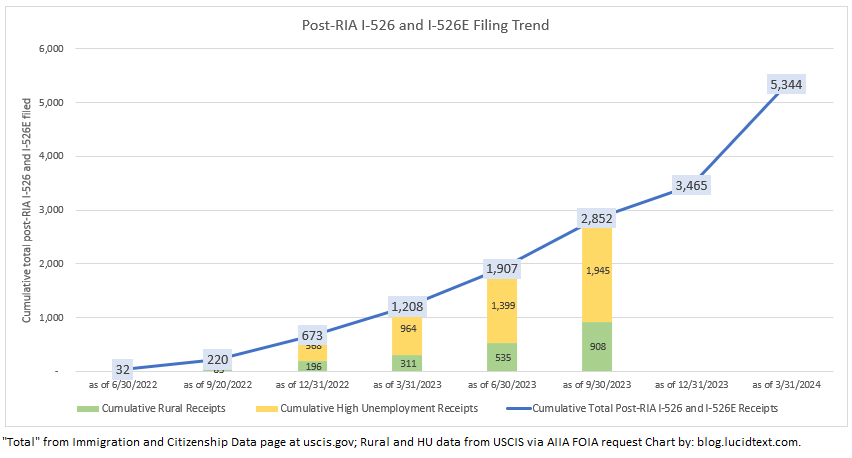FY2024 Q2 (January-March 2024) EB-5 Form Data Update
June 13, 2024 3 Comments
Today USCIS published form receipt and processing data for FY2024 Q2 (January to March 2024) on the USCIS Immigration and Citizenship Data page. I’ve updated my Processing Data page with all the FY24 Q2 EB-5 numbers, and provide charts in this post to highlight the big news.
New EB-5 filings skyrocketed in January to March 2024. Meanwhile, IPO took a large bite out of the EB-5 backlog with impressive productivity that recalls the good old days of 2018. We’re setting up for a busy and crowded time at the EB-5 visa windows in 2025 and beyond. (In other news, I’ve also updated my data repository with key visa-stage EB-5 numbers shared by Department of State at the IIUSA conference last month, to be discussed further in forthcoming articles. See IIUSA’s conference slides and a nice follow-up analysis by Lee Li that gives further detail and clarification.)
Post-RIA I-526 and I-526E Receipt Trend
USCIS reports that a whopping 1,810 I-526E and 69 I-526 were filed last quarter.

Counting up the quarterly reports from April 2022 (following the passage of RIA) to March 2024, we can see that USCIS has reported a cumulative total 5,344 post-RIA I-526 and I-526E filed, and 429 processed. (As a side note, the cumulative count conflicts with the FY24 Q2 period-end pending count. In the past, I’ve noted that the pending number ends up skewed after filing surges – I guess because last-minute end-of period receipts get counted as receipts in the period but only added to pending in the next period.)

In context, since RIA passed two years ago, EB-5 investors have brought at least 5,344*$800,000=$4.275 billion dollars into the U.S. economy. This investment was incentivized by the hope that approximately 5,344/.35=15,000ish visas will be available to these investors plus their spouses and children. (35% is an historical average of principals in EB-5 visas issued.) The number of post-RIA applicants who actually make it to an EB-5 visa will likely be significantly smaller due to country-specific variation and attrition, but the size of the upfront hope is impressive and sobering. Congress has not set aside sufficient annual visa numbers for this level of willingness to invest in economic growth and job creation. We don’t yet know how all I-526E filings break down by country or TEA category (AIIA has another FOIA request in progress for numbers since since November 2023), but this is a lot of prospective EB-5 visa applicants to fit in any lane, including Unreserved given the pre-RIA backlog. EB-5 visa advocacy should already be an urgent priority.
IPO Processing Productivity
As I’ve been reporting based on unofficially obtained data, IPO has made a quantum leap in processing productivity. The first chart illustrates recent processing volume in historical context. The second chart compares FY24 Q4 processing productivity against the size of the backlog for select EB-5 forms. If IPO keeps processing at this rate, the pre-RIA I-526 and I-829 backlogs at USCIS will be gone within 12 months. And then adjudicators currently proving ability to turn out thousands of decisions per quarter will be able to shift focus and make quick work of the post-RIA inventory and incoming receipts. IPO still hasn’t published the RIA-required timely processing fee study, but even better it has gotten on track to actually realize the RIA timely processing goals in the foreseeable future.


is there any status on the 485 processing..should an application made in June’22 have been processed by now..
Any interesting I-829 RFEs or NOIDs recently? Any cases related to source of funds, redeployment, etc.?
Would be great if the waiting time for family petition that was approved almost five years ago, can move forward to allow the change the status of a person who is in the a son of an American citizen and is the country under a student visa. If this doesn’t happens that sibling must leave the country soon. The waiting time is too long. The approval took almost two years, and almost five years have passed after the petition was approved. Instead of bringing new people to the country, why is it that the government don’t move these visas for those who are children of American citizens and havebeen waiting for so long, mainly if we have invested in their education in this country, paying huge amount of money in college?